ornamental sign language in the first order tracery belts - DSpace
ornamental sign language in the first order tracery belts - DSpace
ornamental sign language in the first order tracery belts - DSpace
Create successful ePaper yourself
Turn your PDF publications into a flip-book with our unique Google optimized e-Paper software.
Tenisons, M; Zeps, D. Ornamental Sign Language In The First Order Tracery Belts<br />
Theorem 2 There are exactly b<strong>in</strong>ary matrices with exactly 4 units that are without<br />
automorphisms with respect to reflections versus middle row and middle column and both<br />
diagonals.<br />
Proof This <strong>the</strong>orem differs from <strong>the</strong> previous that <strong>the</strong> condition of non isomorphism is<br />
removed. Because elements are asymmetric <strong>in</strong> <strong>the</strong> mentioned sense <strong>the</strong>y factorize <strong>in</strong> 10<br />
classes of equivalence where each class has elements. Altoge<strong>the</strong>r we get<br />
matrices.<br />
Let us try to get this number 80 without reference to previous <strong>the</strong>orem. In total we have<br />
b<strong>in</strong>ary matrices with units. Let us subtract <strong>the</strong> symmetric ones. We have<br />
symmetric matrices with respect to middle row 12, accord<strong>in</strong>gly, with no unit <strong>in</strong> middle row –<br />
3, and with two unites – 9. This number should be multiplied by 4. Two matrices were with<br />
all units <strong>in</strong> all corners, and no unit <strong>in</strong> corners. These came <strong>in</strong> <strong>the</strong> count with repetition<br />
because of excessive symmetry, thus <strong>the</strong>y we should re-subtract. Thus, we get<br />
. ■<br />
Let us try to build <strong>ornamental</strong> <strong>tracery</strong> from <strong>the</strong>se asymmetric elements we call seeds of<br />
chaos, that are <strong>in</strong> total factorized <strong>in</strong> clases of equivalence. Let us <strong>first</strong> try to count how<br />
many <strong>ornamental</strong> <strong>sign</strong>s we may build <strong>in</strong> <strong>the</strong> most simple <strong>ornamental</strong> <strong>tracery</strong> from <strong>the</strong>se<br />
asymmetric elements.<br />
Def<strong>in</strong>ition 1 Let us call <strong>first</strong> level <strong>ornamental</strong> <strong>sign</strong> code or, simpler, <strong>ornamental</strong> <strong>sign</strong> code or<br />
<strong>sign</strong> code to be a element that is built from 4 asymmetric elements which are<br />
symmetric ei<strong>the</strong>r with respect to both vertical and horizontal reflection, or with respect to a<br />
rotation of elements, all versus <strong>the</strong> center of <strong>the</strong> element, (see pict. 7).<br />
Def<strong>in</strong>ition 2 Let us say that two <strong>sign</strong> codes are equivalent if <strong>the</strong>y are element's<br />
reflection of rows, (see pict.7).<br />
Def<strong>in</strong>ition 2 <strong>in</strong>troduces a simple pr<strong>in</strong>ciple of right and left side equivalence <strong>in</strong> <strong>the</strong> belt,<br />
namely, accord<strong>in</strong>g which belt is readable from both sides equally. This pr<strong>in</strong>ciple has more<br />
deep methodological mean<strong>in</strong>g <strong>in</strong> <strong>the</strong> mak<strong>in</strong>g dist<strong>in</strong>ction between human prehension and<br />
ma<strong>the</strong>matical, see below.<br />
Let us consider allowed <strong>sign</strong> codes by def<strong>in</strong>ition 1 (see <strong>in</strong> pict. 7).<br />
Pict. 7. The illustration of def<strong>in</strong>ition 1. Let us assume <strong>in</strong> <strong>the</strong> place of symbol „R” whatever asymmetric<br />
element with whatever orientation. On <strong>the</strong> left, element shows how <strong>the</strong> code of a <strong>sign</strong> may be built us<strong>in</strong>g<br />
two orthogonal reflections of element. On <strong>the</strong> right <strong>in</strong> two pictures <strong>the</strong> code of a <strong>sign</strong> is built us<strong>in</strong>g two<br />
possible rotations, clockwise and anticlockwise respectively, of element. Two depicted cases by<br />
def<strong>in</strong>ition 2 are dealt as equivalent. This equivalence doesn’t affect <strong>the</strong> <strong>first</strong> way of build<strong>in</strong>g of a code of <strong>sign</strong><br />
because <strong>the</strong> code <strong>in</strong> this case is already symmetric, say, with respect to <strong>the</strong> vertical reflection.<br />
7



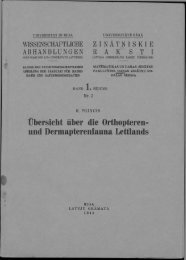
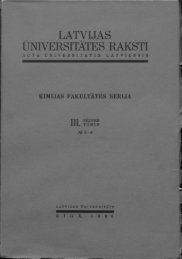
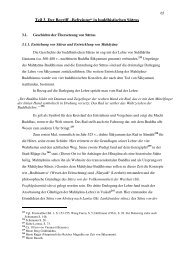
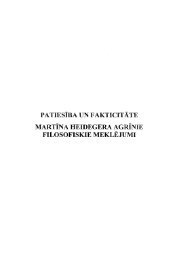
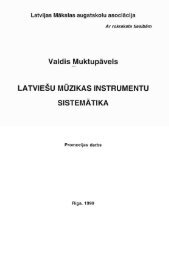
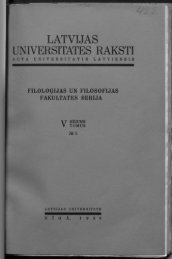
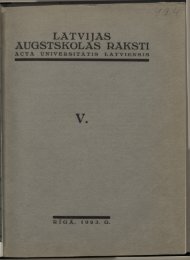




![LATVIJAS] - DSpace](https://img.yumpu.com/11778577/1/190x249/latvijas-dspace.jpg?quality=85)
